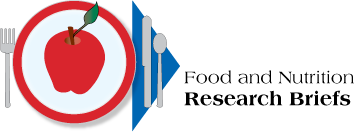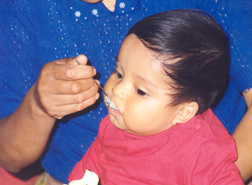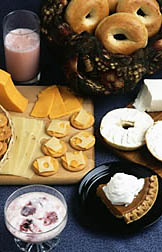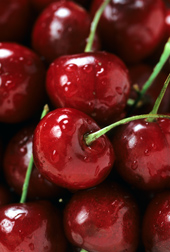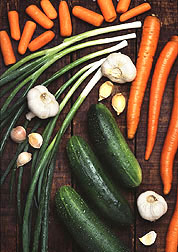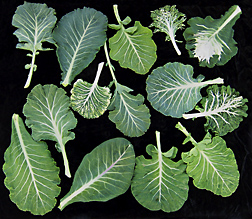| June 2008 |
Increasing Iron Uptake in InfantsResearchers with the Agricultural Research Service (ARS) and Cornell University have developed new techniques for boosting the amount of iron infants absorb from solid food. The team processed freeze-dried samples of chicken liver and beef in a blender, which reduced the meat to small, uniform particles. They found that these particles—which become distributed evenly throughout cereals because of their size and consistency—can serve as a source of supplementary iron for infants. In addition, in vitro tests indicated that iron uptake from cereal supplemented with the beef particles was greater when blending time was increased. This research can help address iron deficiency-induced anemia, a problem that affects as much as one-third of the global population. Scientific contact: Raymond Glahn, (607) 255-2452, ARS Robert W. Holley Center for Agriculture and Health, Ithaca, N.Y. |
|
| New Study Correlates Preschoolers' Screen Time With ObesityA study at the Agricultural Research Service (ARS) Children's Nutrition Research Center in Houston, Texas, has shown that many preschoolers exceed American Academy of Pediatrics (AAP) recommendations that the children spend no more than two hours a day watching television and using the computer. The researchers used data from the National Health and Nutrition Examination Survey that surveyed a diverse group of more than 1,800 preschoolers, ages 2-5, concerning their media consumption or screen time, measured as TV/video viewing or computer use. The researchers compared children watching more than two hours of TV/videos to those watching two hours or less, and computer users to nonusers, relative to various selected health outcomes related to obesity. Results showed that 30.8 percent of the preschoolers studied exceeded the AAP guidelines with TV viewing time alone, not including computer time. Those children who surpassed the AAP recommendations on TV/video viewing were more likely to be overweight or at risk for being overweight. Scientific contact: Jason Mendoza, (713) 798-7055, ARS Children's Nutrition Research Center, Houston, Texas. |
Profiling Promising Plant CompoundsA new standardized profiling method for distinguishing even slight variations in the types and amounts of phenolic compounds in foods has been developed by Agricultural Research Service (ARS) chemists James Harnly and Long-Ze Lin. Discerning potentially beneficial food components is important for conducting clinical nutrition studies and for developing dietary guidance. Using the new method, Harnly and Lin have identified nearly 60 phenolic components in Ginkgo biloba leaves, including many that had never before been detected in the popular herb. They also used the unique profiling method to differentiate phenolics in more than 360 other foods, such as Mexican oregano, Fuji apple peel, soybean seed, broccoli, dry beans, tea and coffee. Scientific contact: James Harnly, (301) 504-8569, ext. 261, ARS Beltsville Human Nutrition Research Center, Beltsville, Md. |
|
| Elderly Improve With Exercise, TooScientists funded by the Agricultural Research Service (ARS) have reported on how the elderly who also engage in physical activity improve their quality of life. In a recent study involving a group of 213 volunteers aged 70 to 89 years, the better the participants' adherence to a physical activity program, the greater their improvements in physical functioning. Those who improved the most reported exercising 150 minutes or more per week. The study was published in Medicine & Science in Sports & Exercise. Scientific contact: Roger Fielding, (617) 556-3016, ARS Jean Mayer USDA Human Nutrition Research Center on Aging, Boston, Mass. |
Dietary Guidelines Associated With Lower Risk of Metabolic SyndromeBased on a close look at the everyday eating habits of a large group of men and women, researchers supported by the Agricultural Research Service (ARS) have found that people whose diets were most similar to the 2005 Dietary Guidelines for Americans (DGAs) were least likely to have metabolic syndrome. For the study, metabolic syndrome was defined as a condition occurring among people who have at least three of the following health risks: abdominal obesity, poor blood sugar control, high blood fats, low levels of HDL "good" cholesterol, and high blood pressure. A cause-and-effect relationship could not be shown between a healthier diet and lower prevalence of metabolic syndrome in this study, according to authors. But among the diet and health indicators of the more than 3,000 participants studied, the researchers found that those individuals with metabolic syndrome tended to consume a diet that was less consistent with the 2005 DGAs. Scientific contact: Paul Jacques, (617) 556-3322, ARS Jean Mayer USDA Human Nutrition Research Center on Aging, Boston, Mass. |
|
| Facts on Fats Could Prompt Healthier EatingThe 2005 Dietary Guidelines for Americans included—for the first time—recommendations that U.S. consumers keep their intake of trans fatty acids as low as possible. Landmark research conducted by Agricultural Research Service (ARS) scientists at the agency's Beltsville Human Nutrition Research Center in Beltsville, Md., contributed to that conclusion. In the ARS study, 58 adult volunteers were fed four different controlled diets, described as moderately high trans fat, high trans fat, high saturated fat, and high "heart-healthy" oleic acid. The study showed that after the volunteers consumed any of the trans-fat or saturated-fat diets, as opposed to the oleic acid diet, their LDL cholesterol levels were significantly increased. Scientific contact: Alanna Moshfegh, (301) 504-0170, ARS Beltsville Human Nutrition Research Center, Beltsville, Md. |
Eating Is Stressful, But Antioxidants Can HelpAntioxidant capacity of volunteers' blood plasma samples declined after eating a test meal that lacked antioxidants, according to Agricultural Research Service (ARS) scientists. But the scientists also found, for the first time, that consuming grapes with that same test meal prevented the decline in plasma antioxidant capacity of the volunteers during the first two hours following the test meal—the time digestion is the most rapid. The experiments were part of a larger study that compared the ability of the human body to use the antioxidants in Bing cherries, dried plums, dried plum juice, kiwifruit, red grapes, strawberries and wild blueberries. Scientists used an ARS-developed method called ORAC, short for Oxygen Radical Absorbance Capacity, to evaluate the fruits' antioxidant capacity. They documented their findings in 2007 in the Journal of the American College of Nutrition. Scientific contact: Ronald Prior, (501) 364-2747, ARS Arkansas Children's Nutrition Center, Little Rock, Ark. |
|
| Best Method to Chill Chickens Depends on WaterScientists at the Agricultural Research Service (ARS) Richard B. Russell Research Center in Athens, Ga., recently compared the two primary industry methods of chilling poultry carcasses in terms of meat quality, food safety and water management. Chilling is an important step in processing poultry before marketing of the birds. Immersion chilling—in which chicken carcasses are submerged in tanks of cold water or an ice-and-water mix—is the predominant method now used in the United States. Dry-air chilling blasts carcasses with cold air, while evaporative-air chilling combines cold air blasts with water misting. Both immersion chilling and air chilling met criteria for limiting bacterial pathogen growth on carcasses. But tender chicken is also very important to consumers. Research showed that air chilling led to better quality of breast fillets and provided higher cooked-meat yields than immersion chilling. Processors could also save about 4.5 billion gallons of water per year if all 9 billion birds processed annually in the United States were air-chilled. Scientific contact: Douglas Smith, (706) 546-3132, ARS Richard B. Russell Research Center, Athens, Ga. |
Fresh Ideas from Nutrition ResearchAgricultural Research Service (ARS) plant breeders in Salinas, Calif., have developed an experimental technique to boost iceberg's nutritional value. Scientists in the agency's Crop Improvement and Protection Research Unit pried open the leaves of iceberg lettuces as they grew, preventing the formation of tightly closed heads. With more surface exposed to sunlight, the lettuces accumulated twice as much iron and calcium and five times as much vitamin C as typical iceberg lettuce. Scientists in the ARS Vegetable Crops Research Unit in Madison, Wis., helped raise beta-carotene levels in carrots, and are now working to produce the same results in cucumbers and melons. The same researchers are also using classical breeding methods to raise levels of heart-healthy compounds in onions and garlic. Scientific contacts: Lettuce—Beiquan Mou, (831) 755-2893, ARS Crop Improvement and Protection Research Unit, Salinas, Calif.; Melons and cucumbers—Philipp Simon, (608) 262-1248, ARS Vegetable Crops Research Unit, Madison Wis. |
|
| Preserving a Unique Collection of Carolina CollardsCollard, a cole crop related to broccoli, cabbage and cauliflower, has always been a local staple in the South. But its commercial cultivation expanded dramatically in the 20th century, and is now dominated by a few hybrid varieties. Agricultural Research Service (ARS) plant geneticist Mark Farnham led a team to look for unique collard varieties in the Carolina coastal plains. The researchers wanted to find and preserve "heirloom" collards, local varieties of the leafy vegetable that had been cultivated from seeds passed down through generations. They collected 87 distinctive collard seed samples from these small gardens—varieties that might otherwise have disappeared in the near future. Scientific contact: Mark Farnham, (843) 402-5300, ext. 5327, ARS U.S. Vegetable Laboratory, Charleston, S.C. |

